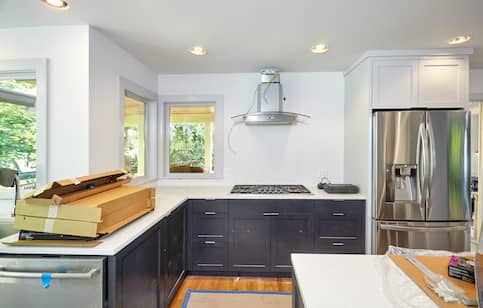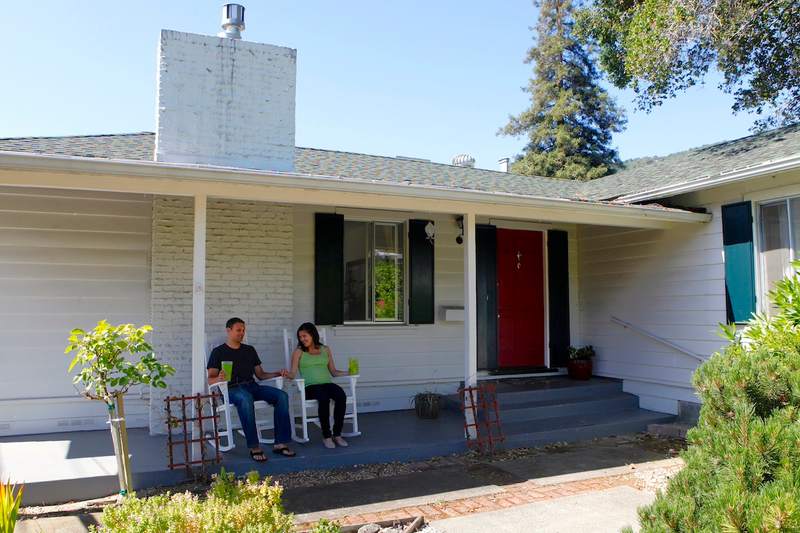If you’re planning a home remodel or renovation soon, you’re probably considering financing options. Home improvements can be pricey, but they can also boost the asking price of your home.
A home equity loan is an option that offers lower interest rates than other loans or types of credit, such as a personal loan or a credit card.
We’ll take a closer look at how home equity loans work, the pros and cons and home equity loan alternatives.
How Does A Home Equity Loan Work For Home Improvements?
So, how do home equity loans work with home improvements? You tap into the equity you’ve built in your home and receive a lump-sum payment from your lender. You can use the money for anything, from paying down high-interest credit card debt to college tuition. However, reinvesting in your home with a remodel, renovation or home improvement project is also a popular option.
How Home Equity Works
Home equity is the difference between what you owe on your mortgage and how much your home is worth. For example, if your home is worth $300,000 and you owe $200,000, you subtract what you owe from your home’s total value.
$300,000 – $200,000 = $100,000
In this case, you have $100,000 in home equity to draw on. Once you have enough equity, you can borrow against it using a home equity loan.
A home equity loan is a secured loan because your home is used as collateral to guarantee the loan. Using your home to secure a loan has risks, but it gives you access to lower interest rates.
Borrowing From Your Home Equity
Your lender will set a limit on how much you borrow when you borrow against your home equity. For example, you may be able to borrow up to 90% of your available equity with a home equity loan starting around $45,000.
Let’s continue with our previous example and see how much you can borrow with $100,000 in equity.
$100,000 ✕ 0.9 (or 90%) = $90,000
With $100,000 equity, you can potentially borrow up to $90,000 to fund your home improvements. You’ll receive the loan amount the lender approves in a single lump-sum payment.
As with any home loan, you pay back a home equity loan in monthly installments, including interest. Because a home equity loan is separate from your primary mortgage and secured by the home, it’s considered a second mortgage. That means you’ll have a second payment to cover each month in addition to your routine monthly mortgage payment.
See What You Qualify For
Buy A Home
Discover mortgage options that fit your unique financial needs.

Refinance
Refinance your mortgage to have more money for what matters.
Tap Into Equity
Use your home’s equity and unlock cash to achieve your goals.
Pros Of Using A Home Equity Loan For Your Remodel
Using a home equity loan to pay for your home’s remodel offers several benefits. Here are some of the top advantages:
Low Interest Rates
You generally pay lower interest rates with a home equity loan because lenders consider home equity loans to be less risky than unsecured loans, like personal loans.
To qualify for the lowest rates, you need a strong FICO® credit score. Lenders typically consider a FICO® Score of 740 or higher a very good credit score and can offer the lowest interest rates. However, you can still qualify for a home equity loan with a minimum score of 680.
Tax Benefits
The interest on a home equity loan can be tax deductible if you use it for a qualifying home improvement. To qualify for the mortgage interest deduction, you must use your home equity loan to “buy, build or substantially improve” your home. Many home remodeling projects qualify. If you’re not sure, ask a tax professional.
If you bought a home after October 13, 1987, you can only deduct the interest you pay on up to $750,000 of combined mortgage debt ($375,000 if married filing separately). For example, if you��’re paying off a $300,000 primary mortgage and a $50,000 home equity loan, you can deduct the interest you pay on both loans.
To claim the mortgage interest deduction, you must itemize your taxes. If you take the standard deduction, you can’t deduct mortgage interest.
It is recommended that you consult a certified and vetted tax professional to ensure that everything is correct and legal before proceeding.
Upfront Lump Sum
When you take out a home equity loan, you’ll receive your funds in a single lump-sum payment, giving you the freedom to use the funds immediately or over time for your home renovation or remodeling project.
Return On Investment
Depending on how you spend your home equity loan dollars, you can increase the value of your home, which should pay off when it’s time to sell. Kitchen remodels, for example, generally boost the value of a home. Adding an extra bedroom or adding a primary bathroom can increase the value of your residence, too.
Flexible Repayment Period
You also have the flexibility to choose the loan term. Based on your needs and your lender’s requirements, your home equity loan repayments can last anywhere from 5 to 30 years.
If you can repay your loan in 5 years, you’ll spend the least amount in interest. But you can stretch out your loan term to 10 or 15 years if what you’re most interested in is a smaller monthly payment. Just know that the longer your loan term, the more you’ll pay in interest over the life of the loan.
Get a Home Equity Loan online.
Let’s match you up with lenders who can help with your unique financial situation.
Cons Of Using A Home Equity Loan For Your Remodel
Like any loan, there are some drawbacks to using a home equity loan. Let’s take a look at some cons.
Secured By Your House
When you take out a home equity loan, your home is the collateral. If you fall behind on your payments or can no longer make your payments, your lender may foreclose on the property. While the potential of losing your home isn’t a risk factor you have to worry about with an unsecured loan or credit card, your interest rates will be much higher, making your home improvement project more expensive.
Locked Into A Lump Sum
You’re locked into the amount you borrow with a home equity loan. For some borrowers, this can be a drawback, especially when they can take advantage of more flexible types of revolving credit, like a home equity line of credit (HELOC) or a credit card, allowing you to borrow the funds you need when you need it.
Let’s say you took out a $50,000 home equity loan to cover the cost of a kitchen remodel, but only spent $40,000. You’re locked into repaying that $50,000 – plus interest. If you want to repay the unused amount early, check your loan agreement or ask your lender whether there is a prepayment penalty.
Closing Costs And Fees
When you take out a home equity loan, you pay closing costs, which include the fees charged by your lender and third-party providers. While closing costs vary, they usually range from 2% to 6% of your total loan amount. For example, your closing costs for a $50,000 loan can range from $1,000 to $3,000.
You’ll need to factor in this cost when budgeting and planning for a home remodel or renovation. When weighing your loan options, you’ll need to compare the upfront costs and what you’ll pay in interest over the life of the loan to find the most affordable deal for you.
Additional Monthly Payment
When you take out a home equity loan, you add another monthly payment to your budget. To ensure you can afford the new payment – along with your primary mortgage and other expenses – use your household budget as your guide.
Other Options For Using Equity For Home Improvements
Interested in exploring your borrowing options? There are other ways to tap into your home’s equity to fund home improvements or renovations.
Let’s look at how these other options to convert your equity into cash compare to a home equity loan:
Home Equity Loan Vs. Home Equity Line Of Credit (HELOC)
Like a home equity loan, the amount you can borrow with a home equity line of credit (HELOC) is based on the equity in your home. Unlike a home equity loan, which provides a lump-sum payment, with a HELOC, you get a line of credit. In other words, a HELOC works like a credit card.
If you take out a $90,000 HELOC to remodel a bathroom and spend $15,000, you only pay back $15,000 with interest during the repayment period (more on that below). With a HELOC, you can borrow as much or as little as you’d like up to the loan limit.
HELOCs typically have two stages. The first stage is the draw period. During the draw period, you withdraw and only repay the interest of what you borrow from your line of credit. The second stage is the repayment period. During this stage, you stop withdrawing and start repaying the entire loan amount plus interest.
Let’s take a look at some major differences between a home equity loan and a HELOC, including factors you should consider before you borrow:
- Interest rates: You can get a home equity loan with a fixed interest rate. A HELOC almost always has an adjustable interest rate.
- Repayment structure: A home equity loan is an installment loan with fixed principal and interest payments for the life of the loan. Since HELOCs mostly have variable interest rates and the amounts you borrow will vary, your monthly payments will fluctuate up or down.
Borrowers usually favor HELOCs for their flexibility, especially home flippers and borrowers with unpredictable expenses. Home equity loans are the steady choice, offering predictable loan terms and stable installment payments.
Home Equity Loan Vs. Cash-Out Refinance
With a cash-out refinance, you’re refinancing your primary mortgage with a larger loan amount. You’ll receive the difference between the new loan amount and your current mortgage balance as a lump-sum payment you can spend on anything.
Let’s say you owe $200,000 on your existing mortgage. If you refinance for $290,000. You’d receive a $90,000 lump-sum payment you can use to pay for anything – including a major home renovation. You’ll start paying back your new $290,000 loan (with interest) in monthly installments.
Let’s look at some major differences between a home equity loan and a cash-out refinance, including factors you should consider before you borrow:
- Replaces your mortgage: While a home equity loan is a second mortgage, a cash-out refinance replaces your mortgage. You’ll only have one monthly payment to make on your home.
- Replaces your interest rate: With a home equity loan, everything stays the same on your original mortgage, from the interest rate to its monthly payment amount. You get a brand-new interest rate with a cash-out refinance, which can be lower or higher.
- Restarts your home loan: A cash-out refinance can restart your loan payments, which can impact the equity you build in your home. With a home equity loan, your amortization schedule stays the same. A cash-out refinance can restart your loan term and slow the pace of building equity at the start of the loan.
A cash-out refinance replaces your original mortgage, which can be great if interest rates have dropped or your debt-to-income ratio (DTI) and credit score have improved. A home equity loan may be a better option for homeowners who are happy with their original mortgage and want to keep it as-is.
Turn your home equity into cash.
See how much you could get.
How To Get A Home Equity Loan For Your Remodel
Applying for a home equity loan is like applying for any other mortgage loan. Let’s take a look at what you can expect during the process.
Your lender will check your credit reports and your three-digit credit score. Your lender will require copies of your most important financial documents, including:
- A government-issued ID
- Two recent pay stubs
- Copies of your most recent bank account statements
- Tax returns from the last 2 years
- W-2 forms from the last 2 years
You’ll fill out an application and your lender will review your information to confirm that you can afford your monthly payment. The lender’s underwriting team will take a close look at your finances. Your lender may contact you if the underwriter has any questions.
Once the underwriting team approves your loan, you’ll close on it, pay the closing costs and then receive your lump-sum payment and a repayment schedule. With your financing secured, it’s time to begin your home remodel.
FAQs On Home Equity Loan For Renovations
Now that you know some of your options, let’s look at some frequently asked questions about home equity loans for remodeling, renovations and home improvements.
Is a renovation loan the same as a home equity loan?
A home renovation loan is different from a home equity loan. Usually, loans advertised as renovation loans are personal loans that have high interest rates. You can use a home equity loan for anything, including home improvements. And because a home equity loan is secured by collateral (your home), a lender will likely offer a lower interest rate.
Does a home equity loan require an appraisal?
Yes, you’ll need a home appraisal for a home equity loan. Home appraisals are a professional, third-party opinion on what your home is worth. The appraisal’s result will help your lender determine how much equity you have to borrow.
What Is the quickest way to get equity out of your home?
Home equity loans and HELOCs are the two fastest ways to withdraw equity from your home. Closing times will vary, but it generally takes 2 – 6 weeks to close. A cash-out refinance is also a good option for a fast turnaround but can take longer than a home equity loan.
The Bottom Line
Consider applying for a home equity loan if you’re ready to start your home improvement or renovation project. You’ll spend less on interest than you would with a credit card or a personal loan. And receiving a lump-sum payment means you can start your renovation project quickly.
Turn your home equity into cash.
See how much you could get.

Victoria Araj
Victoria Araj is a Staff Writer for Rocket Companies who has held roles in mortgage banking, public relations and more in her 15-plus years of experience. She has a bachelor’s degree in journalism with an emphasis in political science from Michigan State University, and a master’s degree in public administration from the University of Michigan.












